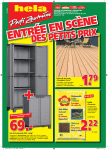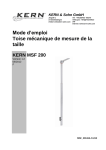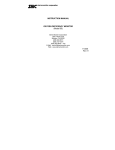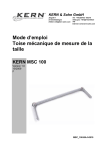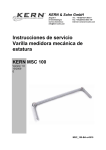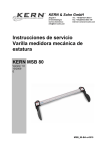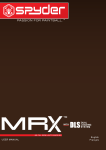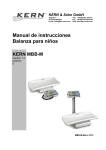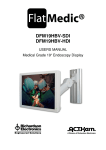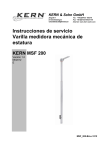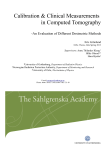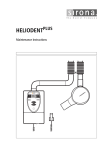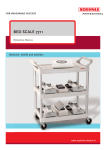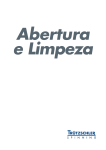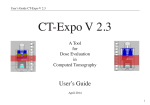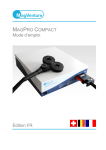Download User Manual CT PHANTOMS T40016, T40017 and
Transcript
User Manual CT PHANTOMS T40016, T40017 and T40027 D698.131.0/1 2005-01 Sa CT PHANTOMS T40016, T40017 and T40027 General Information General Information − The product bears the CE-mark "CE" in accordance with the Council Directive 93/42/EEC about Medical Devices and fulfills the essential requirements of Annex 1 of this directive. The product is a class I device without measuring function (MDD). − The user manual is an integral part of the product. It should always be kept near the product. Observance of the manual is a prerequisite for proper product performance and correct operation. − Operator safety, specified measuring accuracy and interference-free operation can be guaranteed only if original products and parts are used. Furthermore only the accessories listed in this manual are approved by PTW-Freiburg and may be used in conjunction with the product, or else accessories whose use has been expressly permitted by PTW-Freiburg. Safe operation and proper product performance are not guaranteed if accessories or consumables from other manufacturers are used. − PTW-Freiburg cannot be held liable for damages resulting from the use of accessories, consumables from other manufacturers or when the user ignores the instructions and information given in this manual. − The warranty period is 1 (one) year and begins on the day of delivery. It is unaffected by repairs covered by the warranty regulations. − 2 PTW- Freiburg considers itself responsible for safety, reliability and performance of the product only, if assembly, extension, readjustment, modification or repair is carried out by PTWFreiburg or by persons authorized by PTWFreiburg, and if the product is used in compliance with the technical documentation. − This manual is in conformity with the product specifications and all applicable safety standards valid at printing date. All rights are reserved for devices, circuits, techniques, software and names referred to in the manual. − No part of the technical documentation may be reproduced without written permission from PTW-Freiburg. − PTW-Freiburg works in strict accordance with a quality management system which is continuously updated according to national and international standards. PTW-FREIBURG Physikalisch-Technische Werkstätten Dr. Pychlau GmbH Lörracher Str. 7 79115 FREIBURG GERMANY Phone: +49 761 49055-0 Fax: +49 761 49055-70 [email protected] www.ptw.de D698.131.0/1 CT PHANTOMS T40016, T40017 and T40027 Contents Contents GENERAL INFORMATION 2 1 INTENDED USE 4 2 FOR YOUR SAFETY 4 3 COMPONENTS OF THE MEASURING SYSTEM 6 4 MEASUREMENT 8 4.1 4.2 4.3 General Preparing for a Measurement Performing a Measurement 8 8 8 5 EVALUATING THE RESULTS 9 6 CLEANING, PREVENTIVE MAINTENANCE AND DISPOSAL 9 6.1 6.2 6.3 Cleaning and Disinfection Preventive Maintenance Disposal of the Product 9 9 9 7 TECHNICAL SPECIFICATIONS 10 8 ORDER INFORMATION 11 LITERATURE 12 INDEX 12 D698.131.0/1 3 CT PHANTOMS T40016, T40017 and T40027 Intended Use 1 Intended Use 2 For your Safety The CT phantoms are PMMA cylinders representing the head or the body to be CT scanned: The following safety statements are divided into DANGER, WARNING, CAUTION and NOTE. − T40016 is a CT head measuring phantom − T40017 is a CT body measuring phantom − T40027 is a CT head and body measuring phantom, consisting of a smaller and a larger cylinder. The smaller cylinder is used as a head measuring phantom. In order to get a body measuring phantom the smaller cylinder has to be inserted into the larger one. Definitions DANGER Indicates an imminent hazard. If not avoided, the hazard will result in death or serious injury. WARNING CT phantoms are used to determine the Computed Tomography Dose Index (CTDI) in acceptance and constancy tests according to the standards IEC 61223-2-6, IEC 60601-2-44 and FDA §1020.33. Indicates a hazard. If not avoided, the hazard can result death or serious injury. CAUTION For constancy checks the CTDI must be measured at least after a period of six months or after major maintenance and service activities. The CTDI must comply with the reference value within a tolerance of ± 20 %. The user manual describes the use of the test object in acceptance and constancy tests of CT equipment based on the standard IEC 61223-2-6. Indicates a potential hazard. If not avoided, the hazard could result in minor injury or product / property damage. NOTE Provides useful information to assure that you get the most from your equipment. NOTE This manual only describes the use of the CT phantoms. For detailed information about acceptance and constancy tests of CT systems please refer to the standard IEC 61223-2-6, IEC 60601-2-44 and FDA §1020.33. 4 D698.131.0/1 CT PHANTOMS T40016, T40017 and T40027 For your Safety Safety Information WARNING NOTE Shock Hazard – Strictly observe the following warnings. Failure to do so may endanger the lives of the patient, the user and other persons involved. Please observe the user manuals of all connected devices! − Before using the product, the operator must ascertain that it is in correct working order and operating condition. NOTE This symbol stands for: Please observe the manual ! − Liquids must not enter the device. If liquids have entered the device, it must be thoroughly inspected before being used again. Exclusion of operation in the patient environment: Neither the product nor any peripheral device may be operated within the patient environment (see Figure 1). Exclusion of operation as device with patient contact: The device is not for use in direct contact with the patient. Neither the device nor any peripheral device may have contact to the patient. Devices may be connected to other devices or to parts of systems only if it has been ascertained that this connection does not impair the safety of the patient, the operator or the environment. WARNING Suffocation Hazard – Dispose of the packaging material, observing the applicable wastecontrol regulations. Keep the packaging material out of children's reach. Figure 1: Definition of patient environment Patient Hazard – The product is a medical electrical device and must only be handled by persons who are trained in the use of such equipment and are capable of applying it properly. The operator must be trained in the use of the device. D698.131.0/1 5 CT PHANTOMS T40016, T40017 and T40027 Components of the Measuring System 3 Components of the Measuring System Phantom: − − Description of the phantoms: head (T40017) and/or body measuring phantom (T40016) 4 acrylic dummy plugs support, screw, rubber disk head and body measuring phantom (T40027) 8 acrylic dummy plugs support, screw, rubber disk Measuring equipment: − dosemeter DIADOS, DIADOS E UNIDOS or UNIDOS E − CT chamber − for DIADOS and DIADOS E: CT adapter for chamber HV − connection cables The phantoms provide holes to insert a chamber or an acrylic dummy plug for the measurements: − head (T40017) and body measuring phantom (T40016) each with 4 holes off-center and one hole in the center − both cylinders of the head and body measuring phantom (T40027) each with 4 holes off-center and the smaller cylinder one hole in the center Etched crosshairs on the phantom allow exact alignment. A support keeps the phantom in its position on the CT couch. CAUTION Pay attention to use the correct connecting system at chamber and measuring device. UNIDOS or UNIDOS E: BNT, TNC or PTW-M connector DIADOS or DIADOS E: M connector Figure 1: 6 CT chamber, CT body measuring phantom T40016 and CT head measuring phantom T40016 D698.131.0/1 CT PHANTOMS T40016, T40017 and T40027 Components of the Measuring System Figure 2: CT chamber and CT body and head measuring phantom T40027 D698.131.0/1 7 CT PHANTOMS T40016, T40017 and T40027 Measurement 4 Measurement 4.1 General 4.3 Performing a Measurement The phantoms are distinguished only by the diameter, body measuring phantom 32 cm Ø (with phantom T40027 the smaller cylinder inserted into the larger one) and head measuring phantom 16 cm Ø. (7) Set up the CT for the scan. The assembly of the measuring system and the measurement is the same for all phantoms. (9) Stop the measurement. Read the values from the measuring device and enter the data into the protocol. 4.2 Preparing for a Measurement (1) Prepare the protocol. Enter necessary data according to the standard. (2) Set up the measuring device and the chamber according to their user manuals. (3) Put the phantom on the table top of the patient treatment couch. (4) Set up the phantom. Use the support, screw and rubber disk of the phantom. Turn the phantom so that one of the outer holes is in the twelve o’clock position. Tighten the screw. NOTE If you do not use the rubber disk and the screw is not tighten strong enough the support can displace because of the high weight. (5) Insert the chamber into the hole in twelve o’clock position or in the position with maximum exposition. Insert the acrylic dummy plugs into the holes not used. (8) Start the measurement of DLP (dose-lengthproduct) at the measuring device. Perform the scan. (10) Change the chamber position. Insert the chamber into the center hole and the acrylic dummy plugs into the not used holes. CAUTION Change the chamber and dummy plugs carefully. If the phantom is moved the alignment has to be repeated. (11) Set up the CT for the scan. (12) Start the measurement of DLP at the measuring device. Perform the scan. (13) Stop the measurement. Read the values from the measuring device and enter the data into the protocol. For the determination of the weighted Computed Tomography Dose Index (CTDIW) the DLP has to be measured corresponding step (1) to (13) in all four outer holes and the center hole. NOTE For CT equipment performing scans with less or more than 360°: the selected position has to represent the area of maximum patient dose. (6) Align the phantom with respect to the CT plane and rotational axis using the crosshairs of the phantom. 8 D698.131.0/1 CT PHANTOMS T40016, T40017 and T40027 Evaluating the Results 5 Evaluating the Results The evaluation and interpretation of the results are in the responsibility of the user. CTDI Determine the CTDI (Computed Tomography Dose Index) from the measured DLP. Compare the determined CTDI with the baseline value. Compare the deviation with the allowed deviation from the standard. If the deviation is too high take steps to eliminate the errors. CTDIW Determine the CTDIW (Computed Tomography Dose Index) from the measured DLP values. Compare the determined CTDIW with the baseline value. Compare the deviation with the allowed deviation from the standard. If the deviation is too high take steps to eliminate the errors. 6 Cleaning, Preventive Maintenance and Disposal 6.1 Cleaning and Disinfection Wipe off the phantom only with a moist cloth. Do not immerse the phantom into water. Use only the following disinfectants with the given concentrations: − 2% solution of KORSOLIN − 1% aqueous solution SOKRENA − 5 % solution Sagrotan − 5 % solution Gigasept 6.2 Preventive Maintenance Check the phantom before using for mechanical damages. 6.3 Disposal of the Product At the end of the life time of the phantom you have to dispose the components in accordance with legal local requirements. Ensure a careful separation of the materials. The phantom does not contain any hazardous goods. The cost for an eventual return at the end of the product life time is to be borne by the customer. D698.131.0/1 9 CT PHANTOMS T40016, T40017 and T40027 Technical Specifications 7 Technical Specifications Only values for which tolerances or limits are specified are guaranteed. Values for which no tolerances are specified are for information only. Device designation CT head measuring phantom CT body measuring phantom CT head and body measuring phantom Manufacturer PTW-Freiburg Intended Use Determination of the Computed Tomography Dose Index (CTDI) in acceptance and constancy tests Dimensions and Weight Dimensions Weight CT head measuring phantom Cylinder with 16 cm Ø and 15 cm length 3.6 kg CT body measuring phantom Cylinder with 32 cm Ø and 15 cm length 14.4 kg CT head and body measuring phantom Cylinder with 16 cm Ø and 15 cm length and Cylinder with 32 cm Ø and 15 cm length The smaller cylinder can be inserted into the larger one. 14.4 kg 10 D698.131.0/1 CT PHANTOMS T40016, T40017 and T40027 Order Information 8 Order Information CT body measuring phantom 15 cm long acrylic cylinder, 32 cm in diameter. Features hole in the center and four holes off-center for accommodation of CT ionization chamber 30009. Includes 4 blind plugs. For dose measurements in accordance with IEC 61223-2-6 T40016 CT body phantom carrying case Carrying case for CT body phantom T40016 T40016.1.010 Mounting bracket for CT-Phantoms for fixation of the CT head or body measuring phantom to GEMS CT installations T40016.1.020 CT head measuring phantom 15 cm long acrylic cylinder, 16 cm in diameter. Features hole in the center and four holes off-center for accommodation of CT ionization chamber 30009. Includes 4 blind plugs. For dose measurements in accordance with IEC 61223-2-6 T40017 CT head phantom carrying case Carrying case for CT head phantom T40017, DIADOS dosemeter, CT chamber and accessories T40017.1.010 CT head & body phantom T40027 two 15 cm long acrylic cylinders, 16 and 32 cm in diameter. The big cylinder can accommodate the small one. Both cylinders feature four holes off-center and one central hole for CT chamber 30009. For dose measurements in accordance with IEC 61223-2-6 CT phantom and DIADOS E carrying case carrying case for CT phantom T40027, DIADOS E dosemeter, CT chamber and accessories T40027.1.050 CT ion chamber 4.73 cc TM77336 ion chamber for dose length product measurements in CT. Length of measuring volume 150mm, cable length 2.5 m, connecting system M CT ion chamber 3.14 cc TM30009 ion chamber for dose length product measurements in CT. Length of measuring volume 100mm, cable length 2.5 m, connecting system M DIADOS diagnostic dosemeter measures dose, dose rate, dose per pulse, and exposure time with semi-conductor detectors. Electrometer mode, RS232 interface and rechargeable battery included. For 115/230V, 50-60Hz T11003 DIADOS E diagnostic dosemeter complies with IEC 61674. Measures dose, dose rate, dose per pulse, and exposure time with semi-conductor detectors. Electrometer mode, RS232 interface and rechargeable battery included. Requires power supply L991041 T11035 DIADOS CT adapter, connecting system M for connection of a CT chamber type TM30009 or TM77336 to the DIADOS. Supplies the CT chamber with a voltage of 100V T16018 UNIDOS Universal Dosemeter, System M secondary standard reference class dosemeter for dose and dose rate measurements in radiotherapy, diagnostic radiology, mammography and health physics. Includes RS232, rechargeable batteries and mains cord for 115/230V, 50-60Hz T10001 UNIDOS E therapy and diagnostic dosemeter, for dose and dose rate measurements. Connecting system M. Includes RS232, rechargeable batteries and mains cord for 115/230V, 5060Hz T10008 D698.131.0/1 11 CT PHANTOMS T40016, T40017 and T40027 Literature Literature [1] The Council of the European Communities, Council Direc- C tive 93/42/EEC of June 1993 concerning medical devices Cleaning .......................................................................... 9 Components, measuring system ..................................... 6 (Medical Device Directive - MDD) [2] Index The Council of the European Communities, Council Directive 97/43/EURATOM on health protection of individuals against the danger of ionizing radiation in relation to medical D Disinfection...................................................................... 9 Disposal, product............................................................. 9 exposure [3] IEC 61223-2-6 Evaluation and routine testing in medical imaging departments Part 2-6: Constancy tests, X-ray equipment for computed tomography [4] IEC 60601-2-44 Medical electrical equipment Part 2-44: Particular requirements for the safety of X-ray equipment for computed tomography E Evaluating the results ...................................................... 9 G General information......................................................... 2 I Intended use.................................................................... 4 L Literature ....................................................................... 12 M Maintenance.................................................................... 9 Measurement .................................................................. 8 Measurement, performing ............................................... 8 Measurement, preparing ................................................. 8 Measuring equipment...................................................... 6 O Order information .......................................................... 11 P Phantom, components .................................................... 6 Phantom, description....................................................... 6 S Safety information ........................................................... 4 T Technical specifications ................................................ 10 12 D698.131.0/1













